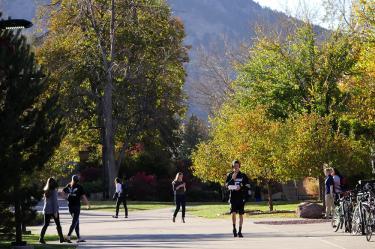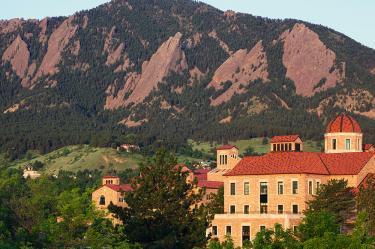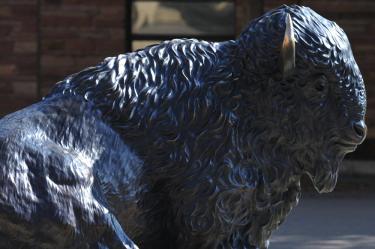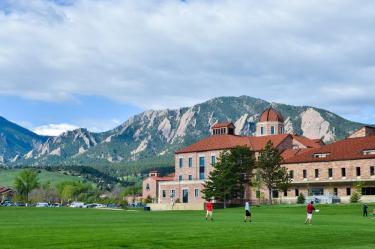Leeds Business Insights Season 2 Episode #3
S2E3: Richard Wobbekind & Brian Lewandowski - Economic Update and Forecast
[00:00:00] Amanda: Welcome to the Leeds Business Insights Podcast, featuring expert analysis to help you stand out from the herd. My name is Amanda Kramer. We are thrilled to be discussing the state of the economy and a look-ahead at the economic environment with Richard Wobbekind, Associate Dean of Finance and the Business Research Division at Leeds, and Brian Lewandowski, Executive Director of the Business Research Division at Leeds. Welcome to Leeds Business Insights, Rich and Brian. And thank you so much for being here today.
[00:00:32] Rich: Our pleasure.
[00:00:33] Amanda: Let's start with the question on everyone's mind—do you think we are in a recession? And if not, might we go into a recession?
[00:00:41] Brian: We're often presented with his question, if we’re in a recession. And as we reflect on the first two quarters of 2022, we were looking at two consecutive quarters of negative GDP growth. And so I think a lot of people, by extension, say, ‘well, then I guess we were in a recession.’
But when we take a look at the National Bureau of Economic Research, the organization that's really charged with calling or dating when a recession begins and ends, it's a little bit more nuanced than that. They do look at overall economic growth, which is embodied in gross domestic product, the value of goods and services that are produced in our economy. But they're also taking a look at factors like payroll employment, household employment, which includes sole proprietors. They look at real personal consumption and they take a look at wholesale trade and retail trade and industrial production and capacity utilization.
So there's a lot of complex factors that they're watching. And when we take a look at those individual components, almost all of those continue to increase in the first and second quarters of 2022. So peeling back the onion a little bit – when we take a look at first quarter GDP declines, it was really driven by a decrease in government spending and was also driven by a worsening trade deficit, where we saw imports outpace the rate of change in exports. But the two components that continued to grow in the first quarter were consumption and investment, which are really important components of our economy.
Consumption represents about 70% of our economy. Investment is about 16% or 17%. So I think that's a pretty positive signal about the first quarter, showing that we were not broadly in a slowdown in this country in the second quarter, we still saw an increase in consumption. We saw investment pull back, but seeing that the consumer continued to spend that's a really important factor showing that people were still out there in the marketplace and had the ability to increase purchases.
Now really, what we need to be thinking about is the future. And what the fourth quarter of 2022 looks like, and the first quarter of 2023. Are we really on the cusp of a slowdown or not?
[00:03:01] Rich: So the data for the third quarter, of course, we won't have in hand until into the fourth quarter, but it certainly looks like there's gonna be positive GDP growth in the third quarter.
We are gonna be talking about a potential recession in 2023, given the extreme movement of monetary policy, the high increase in interest rates. It is likely that we'll see a couple of quarters of negative growth, or even employment loss, if you will if you want the first part of 2023 or the middle part of 2023.
So we look at different things as sort of leading indicators in the economy. One of these series is actually called the leading economic indicators series, produced by the conference board. And that particular series now has had six months in a row of negative readings. We'll usually talk about that being a six-month leading indicator if you will.
So right now people are suggesting that is signaling, at this point, that six months out from now will be in a recessionary environment. Again, we're not thinking severely recessionary. And gonna talk about having GDP growth rate over 1% for next year as a whole, but a couple of quarters, slightly negative growth and slow employment growth.
[00:04:21] Brian: I think, on that, it'll take consumption slowing for us to really dip into a recession. And so, what will cause consumption to fall? I think we're seeing some signals of this right now. We see that employment growth is still strong, but we're seeing inflation start to chip away at the ability to consume. So, high inflation rates that are outpacing wage growth or income growth. Overall inflation is above 8%, but core inflation is above 6%. And we're seeing consumers dip into their savings or reduce their savings to maintain lifestyle. And that, that can only sort of persist for so long before we actually see consumptions starting to fall.
And maybe there's some indicators of that, even in the trade deficit. If we're importing less right now, maybe that's an indication of decreased demand by the consumer, which is leading to the decrease in imports. I think that's going to be critical for us to enter a recession or not in the near term, is what happens with consumption.
[00:05:22] Amanda: You took the words out of my mouth in terms of asking what might be some of the signs or indicators or what would need to happen for us to go into recession. So, tell us more about what's going on with inflation and interest rates right now.
[00:05:34] Brian: Nationally and locally, we've seen the highest rate of inflation that we've seen in the last 40 years in this country. So, it's concerning on many fronts. But I think one of the most concerning underlying components of the inflation rate is that it's very broad-based. It's not really driven by just one or two components within our economy.
There's two ways that we take a look at it. We take a look at overall inflation, and we take a look at core inflation. And core inflation strips off those volatile components of energy and food. And we've seen both of those indicators increasing at rates in excess of the 8%. What that does in the short run is it decreases what consumers can purchase, right? That basket of goods that we allocate our disposable personal income to really shrinks because our dollar doesn't go quite as far. And that's where we've seen people dip into savings, really, to maintain lifestyle. And income has been increasing, but it really has not been increasing at the same rate as inflation.
So, the Fed has jumped in, and they have been attempting to cool the economy in order to reduce inflation. And the tool that they use is, is increasing the short-term interest rate. And what we've seen so far is a 300 basis point or 3% change in the federal funds rate, which is a really dramatic move by the Fed in a very short amount of time that all happened in 2022, so far. And what the Fed has indicated is that, if they don't see prices cooling, they are prepared to even take more steps by increasing interest rates further in order to help reduce inflation.
And so, that has ramifications for the broader economy. I think most notable to many of us is just interest rates on things that we're purchasing every day. That's interest rates on vehicles, or we've even seen interest rates on mortgages increase to the highest rates since 2008, pushing about 7%. But the Fed is not directly controlling or affecting these long-term rates, it's a by-product of what they're setting in the short term for the federal funds rate.
[00:06:44] Rich: So, of course, they've been called in to resolve the problem of inflation with monetary policy, as opposed to using any sort of fiscal policy. And when you look at the key components of inflation, there's three ways we think about inflation. One of them is too much money in the system. One of them is excess demand. And the third way to look at it is from the supply side of the economy.
And so, when we had this particular set of inflation in the economy that we've experienced in the last year and a half, we have had all three of those types of inflation simultaneously. Excess demand was created by all of the fiscal stimulus. The monetary inflation was created by incredibly stimulative monetary policy by the Fed. And then, of course, COVID and supply chain issues, which still persist in the economy. So, all of that's a backdrop for the following comment: the Fed can help with controlling excess demand, and the Fed can help with controlling monetary inflation in the economy. But the Fed can't get rid of the supply chain inflation. Their policies aren't going to solve the supply chain piece. So, that's why some of this inflation is persisting. Even with the Fed pursuing an aggressive monetary policy, we're still seeing some of that supply chain inflation built into the system.
[00:09:04] Brian: And so, what are your thoughts on the supply chain? When will that get resolved?
[00:09:08] Rich: When we're looking at the key elements of inflation, there are three components that account for about 75% of the inflation—shelter or housing, transportation, and food. And right now, we've seen the transportation/energy piece coming back down. But at the same time, we still see the food piece and the housing piece on the rise. So, one would hope that the interest rate policies filtering through to the mortgage rates will help bring down at some point the housing component of that. And then, in terms of the food component, some of that was supply chain, but some of that has been driven by the higher energy costs in the system. It's a significant component of grocery store delivery, and food is actually transportation. So, there's some hope there that the energy/transportation component coming down will filter on through to the food prices as well.
[00:10:02] Amanda: We hear about this lag between monetary policy and increasing interest rates. How long does it take for monetary policy to have an impact on the economy or on inflation?
[00:09:19] Rich: So, you hear this question, it's very common amongst the business community when they're asking questions about the monetary policy, what we call the transmission mechanism. And the academic research that's out there, or studies that have been done, indicate that a minimum sort of lag time is six months. And many of these studies show the lag time being up to 18 months. So, when we are looking at this particular policy change, and we're making these rapid changes in a relatively short period of time, there is some reason to ask that question. Have we felt the entire impact of this increase in the interest rate? Has it really cut back on inflation yet?
So, here we are, several months into this at this point, and we are starting to see the first wave of this, particularly, in, in residential housing. We're also going to start seeing more significant impacts in terms of credit card purchases in other places where the short-term interest rate comes into play in terms of influencing how much the monthly interest payments are on those debt items. And as Brian mentioned earlier in the conversation, we also are seeing that in terms of automobile loan rates. So, we are seeing some major items that are purchased through the credit system having some impact or a diminished demand at this point in time.
[00:11:37] Brian: So, what happens if policy doesn't work? What are the risks that we're looking at right now?
[00:11:42] Rich: The risks that we're looking at right now goes into the whole concept of consumer expectations. One of the reasons the Fed is making these moves so dramatically and going up so fast 300 basis points, yes, but 300 basis points from zero. And the reason they're doing that is because they want to affect how the consumer is thinking about inflation. They don't want consumers to think that this inflation is going to last for a long period of time. Because if the consumer believes that, they start to build that into, not only their consumption patterns but their request for wage increases at work, getting into the so-called wage-price spiral. So, they're really trying to do this to help control consumer expectations.
[00:11:32] Brian: And the most recent confidence reports that come out show consumers are expecting inflation to ease in the future. So, their price expectations are actually improving.
[00:12:36] Rich: Yes. So, even though there may be some criticism that inflation is not coming down fast enough—it seems to have peaked, but it's not coming down fast enough—the expectations on the part of consumers have in fact come down, which is good news for the Fed. I mean, you could argue the Fed is looking at that and saying, "We're winning. We just need to keep winning the battle with inflation."
[00:12:57] Brian: So, what's the worst-case scenario that we're looking at? If we continue to have high inflation because it's partially driven by supply chain constraints, which are somewhat out of the Fed's control, and we stagnate our economy by increasing interest rates, so we're effectively stuck in a very slow or no-growth environment with high inflation, and we run out of tools from the Fed to help, what is the situation that we're in?
[00:13:24] Rich: Well, you sort of described it in the question. The situation is stagflation—something that we haven't seen since 40 years ago in the 1980s—where you have this stagnating or even recessionary economy, and you still have a high price level. But enough of that demand will have been pulled back over time that you are going to start to see some effects on that inflation level. You're choking off demand with these higher interest rates. So, you will see some reduction in the inflation rate. The problem is, as Chairman Powell said, there may be some pain along the way. It's not going to be without some potential employment loss. And it's certainly some sectors of the economy suffering more than others.
[00:14:07] Brian: And that's a really interesting environment that we're in right now because we've had such strong job growth. If we take a look at a factor that's a signal of demand for workers, the JOLTS number, the job openings number, that's signaling that there's still extremely strong demand for workers. So, it appears that the employment market isn't as much at risk as it has been in the past when we've been in situations like this where, where we're perhaps on the cusp of a recession. We usually see slowing job growth, lower demand for workers at this point.
[00:14:40] Rich: Absolutely. So, what is that reflecting, Brian? We think about that, it's really reflecting a different environment in terms of demographics, right? We don't have as many workers in the workforce. We don't... we don't have as many people coming to the U.S., immigrants to the U.S., very slow birth rates in the country. So, with the pop- overall population growing so slowly and with the aging of the population, the baby boomers, and so on, there really is a scarcity in the workforce. And that scarcity in the workforce, a very tight labor market, is leading us to say, "I'm going to be very careful before I lay somebody off for my business, because it's really hard to find somebody when I need that person." And I think we're seeing that reflected right now in, in the weekly jobless claim numbers. They're very low. Employers are very reluctant to lay anybody off, even if they see their business slowing a little bit.
[00:15:34] Brian: Yeah. And perhaps, if they are seeing some slowing sales or slowing demand, they're going to continue hiring a person that they've already started because it's sort of like a panic buying, right? It's panic hiring, making sure that you can get those workers while you can in this tight labor environment.
[00:15:51] Amanda: We have businesses, particularly in Colorado, talking about labor shortages. Can you tell us a little bit more about what we're seeing in the Colorado labor market?
[00:15:59] Brian: Colorado's job growth has remained comparatively strong. And we have one of the best job recoveries in the U.S. We're in roughly the top 10 or top 15 for the job recovery from the pandemic recession. And even taking a look year over year right now, we're in the top 12 for year-over-year job growth. We're performing comparatively well. The demand for workers is also strong in Colorado. We can take a look at the job openings number locally and see that there's plenty of demand for workers.
But we suffer from some of the same constraints that every state is suffering from and many businesses are suffering from, where there is a shortage of workers or a lack of supply of workers to fill all of these jobs. And Rich described it largely due to, to demographics, where the number of people overall in the labor force increased and peaked in about the year 2000. And that was the baby boomers entering the workforce and, and then ultimately, reaching retirement age starting in the early 2000s. That's when we saw labor force participation really crest. And that decrease was accelerated by the Great Recession. And then it rebounded a little bit. And then it, it really was depressed by the pandemic recession.
So, now, we've seen some rebounding in labor force participation. Colorado is fortunate that we're one of the states where we have the highest labor force participation rates in the country. We're actually second highest right now in the percentage of our adult working-age population. So, we do have a comparative advantage there.
But we have a lot of people who work more than one job. And what we saw nationally is, these people who had a tendency to, to hold more than one job—in the data, they're called multi-job holders—we saw a sharp reduction in the number of people who are multi-job holders. Still, today, there's about a deficit of 700,000 or so people nationally who used to hold more than one job and no longer do. Maybe, they upskilled to do a different job. Maybe, they are just surviving doing one of their former two jobs. Maybe, they've left the workforce altogether. We don't really know all of their circumstances.
But that's problematic, especially for some of our key tourism industries in the state. So, think about restaurants and hotels. Think about the retail industry. Many of these industries are ones where, maybe, you have somebody working at a ski resort during the day and working at a restaurant in the evening. Having fewer of these people holding more than one job really creates extra pressure on those industries. So, effectively, we need twice as many people to cover the same number of jobs that we had before. I don't know that we'll actually get back to where we were in terms of multi-job holders unless there is enough sort of economic pressure because of the rising interest rates or rising inflation that puts pressure on consumers, where there's actually a burden or a need for people to re-enter the workforce or take on a second job just to make ends meet.
[00:19:06] Amanda: All right. So, you two are forecasters. What are you forecasting for the nation and for Colorado for the remainder of 2022 and into 2023?
[00:19:15] Rich: First of all, I hope we're forecasting the same thing, the two of us. But let me be more serious and say, clearly, the economy is in a slow-down mode, and certain sectors of the economy highlighted earlier, residential construction, in particular, we're seeing a kind of slowdown there that will be impacting GDP numbers in the third quarter, the fourth quarter, and certainly, in 2023. So, our overall GDP number for 2022 1.5% or so by the end of the year. But 2023 probably going to be even lower than that, with a couple of quarters of recession mixed in there. Probably, a GDP growth rate somewhere down in the 1% range.
And while people in Colorado would like to think we're very different, we still have so many businesses that are tied to the national economy. They're selling to firms in other states or other countries. And even industries like tourism, we rely on people coming from other parts of the country to be tourists in Colorado. So, when we look at these different pieces, as the nation goes, so goes Colorado, to some extent. So, the forecast for this year is significant job growth. At the end of the year, we're looking for, perhaps, 112,000 jobs to have been added in 2022—a very strong year. And lots of the sectors getting back to pre-pandemic levels—not everyone, but many of them. Over 3% job growth rate. But next year, it slows quite a bit. And we're anticipating a decline to about 58,000 new jobs in 2023. So, that's about half the growth rate of 2022 in terms of employment. Still, very solid, positive, about half the rate and about half the number of jobs.
We're anticipating a slower environment, but not particularly a negative environment—a GDP recession at the national level that just slows growth down for the year overall and then a bounce back a little bit further on out. And again, a lot of this is being triggered by the Fed's attempts to control inflation with these higher interest rates. And we're not suggesting they're not needed. You really don't want inflation to become permanent in the system. And you don't want expectations to get entrenched around inflation. So, the Fed policy has a lot of logic to it, but it does ultimately create some pain.
[00:21:43] Amanda: And Brian, anything else to add there before we go into what are you keeping your eyes on, moving forward?
[00:21:47] Brian: I think it's interesting to reflect on what we were thinking last fall when we were doing our forecast because we had underestimated the number of jobs that would be added in the Colorado economy in 2022. So, our thinking at the time was that we had a supply constraint for workers, which I still think we do. But Colorado surprised us in the number of people who re-entered the labor force. So, that's what helped us really achieve the 100,000-plus jobs that we've been able to grow in the state in 2022.
That calculus changes a little bit in 2023, where it becomes less of a supply constraint and more of a decrease in demand for workers because of the slowing of the economy. So, I think that slower growth will be driven by a slower-growing economy and less of these other structural impacts that we have.
[00:22:40] Amanda: Thank you for that. And what are you two keeping your eyes on going forward?
[00:22:44] Brian: One thing that we do on a quarterly basis is the Leeds Business Confidence Index. And we asked about 300 business leaders across Colorado their expectations for the economy three months out and six months out. And it's a very simple questionnaire where we ask them their outlook for the national economy, state economy, sales, profits, capital expenditures, and hiring. But the more interesting piece of that survey is we ask them why. So, what's the primary reason for their response?
And we've been hearing about the challenges that these businesses are facing, and these individuals are thinking about. And it includes factors like a labor force constraint or worker shortages. We hear about supply chain issues. We hear about rising inflation. And we hear about interest rates, as really the four top issues that they are watching. And then there's a long tail of other issues that they mention, including things like the war between Russia and Ukraine and how that can spill over into Europe and the election cycle and how there's uncertainty in the economy because of these things. But we're really watching these four main issues that I mentioned a moment ago. And I think those will be good indicators for what to expect in 2023.
[00:23:59] Rich: So, I'm looking at some other things that are, maybe, broader. And starting sort of at the national level, how effective is this monetary policy in getting the inflation rate to come down? Because the faster they can get the inflation rate to come down, the sooner they're going to be able to back off of continued interest rate increases. And we didn't really talk about this in the monetary section, but I think everybody is forecasting pretty much at least 100 basis points or 1% additional increase to the short-term rate. And even the Fed, in their releases where they show something called the dot plot of what they're estimating, that's close to 4.5% of what they are thinking interest rates are going to be.
So, the sooner the inflation seems to turn and get under control, the sooner they'll be able to back off on that particular policy instrument. And that certainly will help speed up the growth rate of the national macro-economy. I guess my optimism there still hinges around energy prices falling and how that filters through the economy—to food, but also to manufacturing and other areas as well.
And the state continue to be very concerned about affordability. If it's too expensive to live here, then that's going to be a deterrent. And Brian already highlighted this in his comments. We think it already is a deterrent to lower-income workers. It's become less desirable for the lower-wage industries already. And even for things like government employees and so on, we have so many local government employee positions open at this particular point in time, nationally, but especially, in Colorado. So, that's, that's a concern area.
And then a bigger, broader one is climate/water, specifically. And Colorado is a state that's very dependent on... agriculture is very dependent on water. A lot of our economic growth has been very dependent on water. And certainly, our ski industry and outdoor experiences, river rafting and fishing, and all of those things are very dependent on water. And so, when we look at the potential for drought, that gives an element of fear to many different sectors of the Colorado economy. It's certainly something we pay a lot of attention to in terms of its impact.
[00:25:32] Amanda: Every episode, we have an LBIdea or a key takeaway. And one of the key takeaways here is that this slower growth period is an opportunity for businesses to stop and assess their processes assess the cost of doing business, versus the period of time when we were in high growth, and you wanted to move feverishly to make sure that you didn't miss the opportunity to make a sale. Now, you're able to be a little bit more thoughtful. And you should take the opportunity to do so.
[00:26:53] Rich: The truth of slower growth environments on the business side require the business to more carefully analyze how they're doing things and the cost of doing things. When you're in a very high-growth environment, you're concerned with making sure the order gets out the door or it gets fulfilled. And you really don't want to miss the opportunity to make the sale. But when you get in a slower growth environment, you start to think about, are we doing this in the best way. Do I have the best worker to do this? And you think more about, do I have the right skill sets with my employees? It's an opportunity to assess, to take a breath and to assess. And there have been many businesses. We have a lot of high-growth ventures in the state of Colorado right now. And they're going at breakneck speed, and they have been. And a little bit slower growth might not be the worst thing in that scenario.
[00:27:44] Amanda: And go ahead, Brian.
[00:27:45] Brian: Colorado has a pretty strong entrepreneurship and innovation ecosystem. We've had a lot of startup companies come out of the state. This is known to be a place now to start businesses, sort of away from the coast. We've seen venture capital follow this activity. And I think one of those risks in a higher interest rate and slower growth environment is that we see some of that funding dry up or at least get smaller. So, it, it can hurt this innovation ecosystem that we've been organically developing in the state.
[00:28:17] Amanda: Thank you so much, Rich and Brian, for being here with us today. It's always great to hear from you.
[00:28:22] Rich: It was our pleasure. Thank you very much.
[00:28:24] Brian: Yeah, thank you.
[00:28:27] Amanda: Thank you again for listening to Leeds Business Insights. Don't miss a single episode. Subscribe to Leeds Business Insights wherever you get your podcasts. You can also find more information about our podcast series at leeds.ly/LBIpodcast.
The Leeds Business Insights podcast offers a cutting-edge perspective of trending topics, along with actionable insights from faculty, alumni and global leaders, to help you navigate the evolving world of business.
We invite you to subscribe wherever you get your podcasts, read about our latest episodes or listen to the most recent podcast below.







